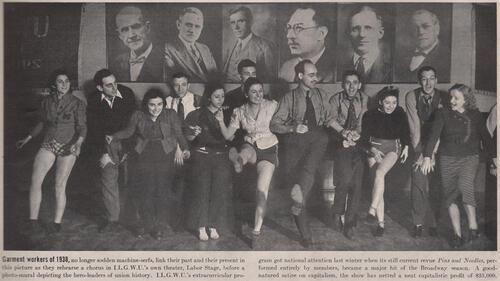Education and Culture
Excerpt about the ILGWU from LIFE Magazine
I.L.G.W.U. objectives lie in three fields, whose 1, 2, 3, both in importance and chronological sequence are 1) Economic; 2) Educational and Social; 3) Political.
The union’s clubrooms, its dances and its games fill a social gap which might elsewhere be filled by a church or Y.M.C.A. The most spectacular manifestation of the social aspect is…I.L.G.W.U.’s million dollar Unity House.
…Yetta Henner lives in New York City, is poor, works as a finisher (she snips loose threads off rayon panties) in the Mitchel Schneider shop and belongs to I.L.G.W.U.’s Local 62. So Yetta…exercises, learns, dances within her union.
Discussion Questions
- Why do you think the Union has social and cultural objectives for its members that go beyond what happens in the workplace?
- How do these union-provided services benefit the union and how do they benefit workers?
Garment Workers Eating Together Before Union-Sponsored Class
he class which Yetta attends once a week... starts at 6:30 in the evening. Since Yetta quits work at 5:30, she cannot get home for dinner. So the union provides a free buffet of sandwiches, coffee, cake. Here she sits with others of her class in a small classroom talking and finishing her coffee. When they have all finished, they will go to the next room where the union, having given them food for their stomachs, will give food for their eager minds.
Photograph by Hansel Mieth in "ILGWU: A Great and Good Union Points the Way for America's Labor Movement," LIFE Magazine, August 1, 1938, 47.
Discussion Questions
- What do you see in this picture? What do you notice about the people in the picture? (Don’t analyze, infer or describe. Just tell what you see.)
- Read the text in the box on the picture. Does this caption add to your understanding of the picture? If so, how?
- Look again at the picture. What else do you notice about what’s happening in this picture now that you’ve read the caption?
Garment Workers Rehearse a Chorus for ILGWU's Theater, Labor Stage
Garment workers of 1938, no longer sodden machine-serfs, link their past and their present in this picture as they rehearse a chorus in the I.L.G.W.U.'s own theater, Labor Stage, before a photo-mural depicting the hero-leaders of union history. I.L.G.W.U.'s extracurricular program got national attention last winter when its still current revue Pins and Needles, performed entirely by members, became a major hit of the Broadway season. A good-natured satire on capitalism, the show has netted a neat capitalistic profit of $35,000.
Photograph by Hansel Mieth in "ILGWU: A Great and Good Union Points the Way for America's Labor Movement," LIFE Magazine, August 1, 1938, 45.
Discussion Questions
- Why do you think the union had its own theater and why would workers be involved in it?
- How are the values you identified in the first question demonstrated in the picture itself?
- How do the pictures of the past union leaders (behind the dancers) relate or connect to the rehearsal?
International Ladies' Garment Workers' Union Social Psychology Lecture, 1926
Discussion Questions
- Why do you think the ILGWU’s Unity House recreational facility sponsored talks on topics such as social psychology, as pictured here, or art history, for example?
- What do you notice about the people in the audience?
- What do you think the union members attending such lectures together in the Unity House setting brought back to their work lives from these experiences?





